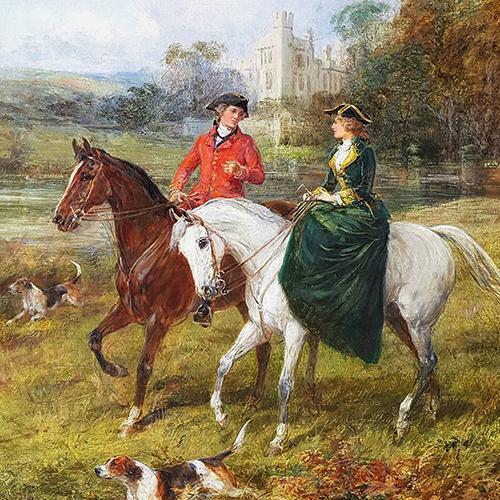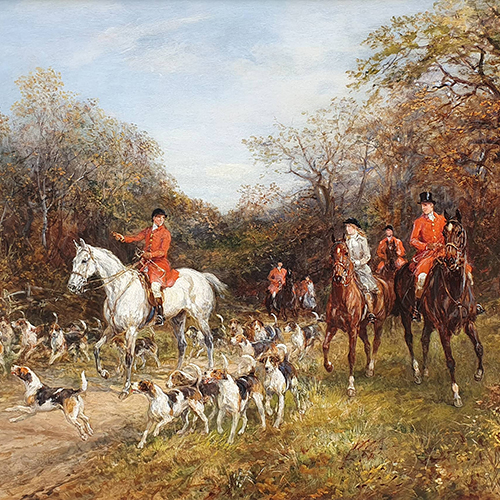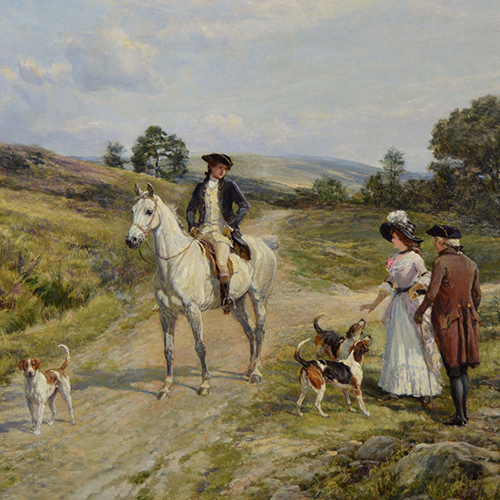

One of the foremost equestrian artists of the Victorian era, Heywood Hardy was born in Chichester, West Sussex, in 1842. The youngest of 10 siblings, Heywood’s family was blessed with a plethora of artistic and musical talents.
His father, James Hardy Snr (1801-1879) had played principal trumpet in the Private Band of Music to King George IV, before working as a portrait artist and Teacher of Drawing in Brighton and Lewes. Three of Heywood’s uncles were also members of the Royal Private Band of Music, including Willliam Hardy who later became the conductor of the Private Band of Queen Adelaide, wife of William IV.
No doubt encouraged by their father’s guidance, three of Heywood’s siblings were also accomplished painters. Brothers James Hardy Jnr and David Hardy specialised in sporting pictures and genre paintings respectively, while sister Ada was a portrait artist. In addition, cousins Frederick Daniel Hardy and George Hardy also achieved acclaim for their rural genre paintings.
Heywood’s father James Snr is known to have been a somewhat volatile character, an attribute that, following a move to Bath in 1846, would seriously tarnish his reputation. Around this period, he developed a religious fervour, bordering on fanaticism, and is known to have lost significant patronage by attempting to impose his beliefs on his wealthy benefactors. Worse still, he took to preaching on street corners in a bid to spread his message, much to the irritation of the general public.
 This irascibility proved too much for young Heywood who left the family home aged 17, citing the “quarrelsome nature of his father” for his departure. Settling in nearby Keynsham, he earned a meagre living as a painter and whilst still just 21, was able to exhibit two landscapes at the Royal Academy in 1864.
This irascibility proved too much for young Heywood who left the family home aged 17, citing the “quarrelsome nature of his father” for his departure. Settling in nearby Keynsham, he earned a meagre living as a painter and whilst still just 21, was able to exhibit two landscapes at the Royal Academy in 1864.
Later that year, having taken a temporary commission as an Ensign with the 7th Somerset Rifle Volunteer Corps, Hardy scraped together the funds to enrol at the École des Beaux-Arts de Paris. When not studying, the young artist would hone his talents by copying artworks in the Louvre Museum. It was also in Paris that Heywood would encounter the early Impressionist movement, a genre that would have a subtle but nonetheless noticeable effect on his own developing style.
Upon returning to England in 1868, Hardy settled at Goring in Oxfordshire where he found work producing portraits, landscapes, and animal paintings for wealthy estate owners. In keeping with his family’s musical traditions, Heywood would often entertain his patrons at musical evenings by performing on the mandolin, zither, or English guitar.
Perhaps more importantly, Hardy found love too in 1868, marrying Mary Beechey, daughter of Rear-Admiral Frederick William Beechey, President of the Royal Geographical Society. The pair raised four daughters, two of whom, Nina and Mabel, perhaps not surprisingly went on to become gifted painters.
 Having moved to the popular artists’ commune of St John’s Wood, London, Heywood switched his focus to animal painting. He studied anatomy with the eminent zoologist Alfred Henry Garrod and enhanced his studies with the purchase of a deceased lion from London Zoo which he had stuffed and mounted by London’s leading taxidermists Rowland Ward.
Having moved to the popular artists’ commune of St John’s Wood, London, Heywood switched his focus to animal painting. He studied anatomy with the eminent zoologist Alfred Henry Garrod and enhanced his studies with the purchase of a deceased lion from London Zoo which he had stuffed and mounted by London’s leading taxidermists Rowland Ward.
Hardy’s endeavours paid dividends in 1873 when he exhibited a painting of fighting lions at the Royal Academy to widespread acclaim. In reviewing his submission, The Times proclaimed, “The picture at once gives a great rise in artistic rank to the artist.” Around this time Hardy also found work as an illustrator with the Graphic, and the Illustrated London News, which helped further his recognition and appeal.
But it was for his equestrian art that Heywood received the most commercial success, with his services in high demand throughout the late 19th and early 20th centuries. Hunting scenes and equestrian portraits were amongst his most popular themes; indeed, Hardy is known to have painted at least three Grand National winners, not to mention countless Hunts and foxhounds.
A sign of Heywood’s growing influence within the art world came in 1880 when he was a founding member of the Royal Society of Painter-Etchers, and later in 1891 of the Royal Society of Portrait Painters. He was also an associate of the Royal Watercolour Society and a member of the Royal Institute of Oil Painters.
 In 1909, Hardy retired to his native Sussex, making a home at the picturesque coastal village of East Preston. Ironically his final works would be his most controversial as Heywood was commissioned to create a series of biblical frescoes to mark the 700th anniversary of the church of St Mary the Virgin at nearby Clymping.
In 1909, Hardy retired to his native Sussex, making a home at the picturesque coastal village of East Preston. Ironically his final works would be his most controversial as Heywood was commissioned to create a series of biblical frescoes to mark the 700th anniversary of the church of St Mary the Virgin at nearby Clymping.
The eight panel paintings charting the life of Christ caused quite a stir on their unveiling as they depict Christ walking through the Sussex countryside surrounded by recognisable local dignitaries of the era. They can still be seen today in the north transept at Clymping, along with a memorial plaque dedicated to Hardy, whose ashes are interred in the grounds.
Click here to view works currently available from BADA members.

